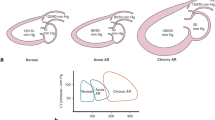Abstract
The hemodynamics of isolated large ventricular septal defect with an intact atrial septum results in greater mitral valve (MV) annular dilation and an increased incidence of mitral regurgitation (MR). MR will resolve in most patients after surgical VSD closure alone without MV repair.

Similar content being viewed by others
References
Delmo Walter EM, Siniawski H, Ovroutski S, Hetzer R (2010) Mitral valve growth after posterior annular stabilization with untreated autologous pericardial strip in children with mitral valve insufficiency. Ann Thorac Surg 5:1577–1585
Hisatomi K, Isomura T, Sato T, Kosuga K, Ohishi K, Katoh H (1996) Mitral valve repair for mitral regurgitation with ventricular septal defect in children. Ann Thorac Surg 6:1773–1777
Honjo O, Ishino K, Kawada M, Akagi T, Sano S (2006) Midterm outcome of mitral valve repair for congenital mitral regurgitation in infants and children. Interact Cardiovasc Thorac Surg 5:589–593
Kleinman CS, Tabibian M, Starc TJ, Hsu DT, Gersony WM (2007) Spontaneous regression of left ventricular dilation in children with restrictive ventricular septal defects. J Pediatr 6:583–586
Lai WW, Ko HH, Mertens LL, Cohen MS, Geva T (2009) The normal pediatric echocardiogram. In: Lai WW, Mertens LL, Cohen MS, Geva T (eds) Echocardiography in pediatric and congenital heart disease: From fetus to adult 2009. Oxford, Blackwell, pp 34–50
Nielsen JC, Lytrivi ID, Ko HH, Yau J, Bhatla P, Parness IA et al (2010) The accuracy of echocardiographic assessment of left ventricular size in children by the 5/6 area x length (bullet) method. Echocardiography 6:691–695
Papadimitriou JM, Hopkins BE, Taylor RR (1974) Regression of left ventricular dilation and hypertrophy after removal of volume overload. Morphological and ultrastructural study. Circ Res 1:127–135
Quarti A, D’alfonso A, Colaneri M, Baldinelli A, Ricciotti R, Bettuzzi MG et al (2009) Edge-to-edge technique: is it also useful in children? J Cardiovasc Med (Hagerstown) 11:848–851
Sluysmans T, Colan SD (2005) Theoretical and empirical derivation of cardiovascular allometric relationships in children. J Appl Physiol 99(2):445–457
Walsh MA, Benson LN, Dipchand AI, Redington AN, Caldarone CA, Van Arsdell GS et al (2008) Surgical repair of the mitral valve in children with dilated cardiomyopathy and mitral regurgitation. Ann Thorac Surg 6:2085–2088
Author information
Authors and Affiliations
Corresponding author
Rights and permissions
About this article
Cite this article
Mahadin, D.R., Srivastava, S., Parness, I.A. et al. Outcomes of Mitral Regurgitation Associated With Large Ventricular Septal Defect and a Normal Mitral Valve Apparatus: Does Intact Atrial Septum Have an Impact?. Pediatr Cardiol 32, 1128–1131 (2011). https://doi.org/10.1007/s00246-011-9994-8
Received:
Accepted:
Published:
Issue Date:
DOI: https://doi.org/10.1007/s00246-011-9994-8




